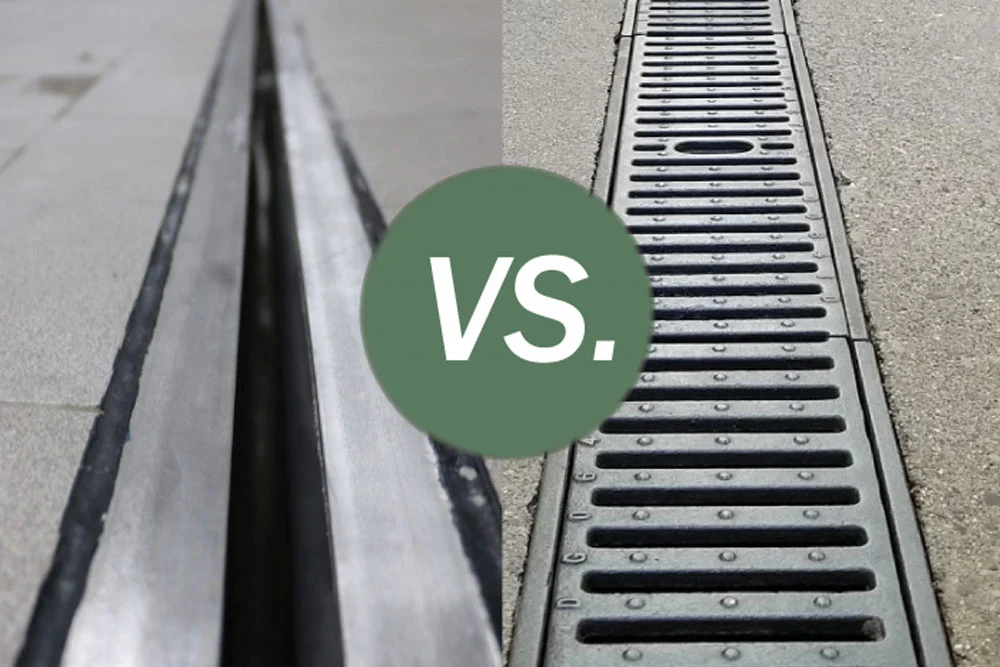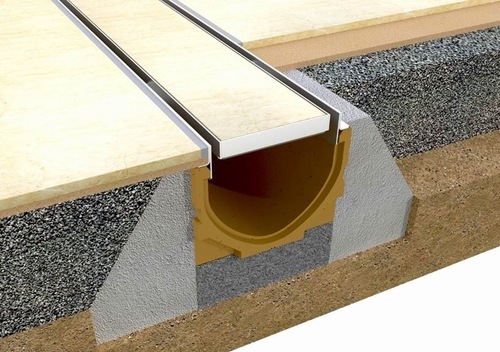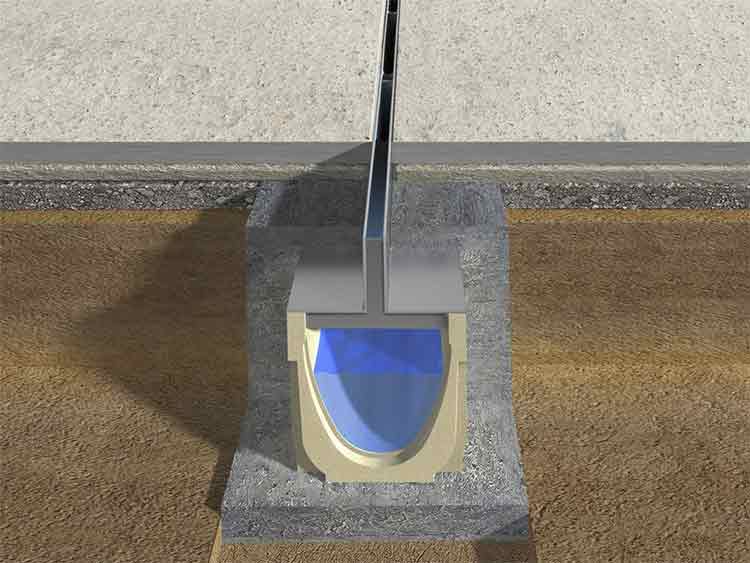Learning
Slot Drain vs. Trench Drain: A Comparison of Landscape Drains

When it comes to landscaping projects, we often focus on the aesthetic aspects such as choosing the right plants and creating a visually appealing design. However, one element that is often overlooked but is crucial for the long-term health and functionality of your outdoor space is a proper drainage system. A well-designed landscape drain system plays a vital role in maintaining the integrity of your property by preventing water damage and erosion.
One of the main benefits of an effective drainage system is its ability to control and redirect excess water away from your property. Without proper drainage, rainwater can collect in low-lying areas or pools around your foundation, leading to issues such as soil erosion, flooded basements, and even structural damage. Additionally, stagnant water can create a breeding ground for mosquitoes and other pests, posing health risks to you and your family.
Another important aspect of landscape drainage systems is their contribution to preserving soil quality. By directing excess water away from your garden beds or lawn areas, a well-designed drain helps prevent oversaturation which can lead to root rot or other plant diseases. Furthermore, consistent moisture levels provided by an efficient drainage system promote healthy microbe activity in the soil, enhancing nutrient availability for plants.
While it may not be the most glamorous part of your landscaping project, implementing a reliable landscape drainage system can save you time, money, and headaches down the road. Not only does it protect against potential water damage but also promotes healthy plant growth by maintaining optimal moisture levels in your soil.
What is a Slot Drain?
While Trench Drains have long been the go-to choice for landscape drainage systems, Slot drains are gaining popularity due to their unique design and functionality. A Slot Drain is a narrow, linear drain that typically sits flush with the ground surface, offering a sleek and discreet look. It features narrow slots or channels along its length through which water can flow, effectively eliminating the need for grates or covers. This innovative design not only enhances the aesthetics of any outdoor space but also prevents debris buildup and potential tripping hazards.
One notable advantage of Slot Drains over Trench Drains is their ease of installation. Unlike Trench Drains, which require extensive excavation and placement of multiple components such as grates and frames, Slot Drains can be installed quickly and efficiently. With their simple design consisting of just one continuous channel rather than individual trench sections, they offer significant time-saving benefits during installation.
In addition to their easy installation, Slot Drains also provide excellent water flow capacity. The multiple narrow slots allow for efficient drainage by preventing large amounts of water from pooling on surfaces. This makes them highly effective in areas prone to heavy rainfall or standing water issues.
Advantages of Slot Drains
Slot drains offer numerous advantages over traditional trench drains, making them an excellent choice for landscape drainage systems. First and foremost, slot drains are highly efficient at removing large volumes of water. The narrow opening of the slot drain helps to prevent debris from clogging the drain, ensuring a continuous flow of water even in heavy rainfall.
Another advantage of slot drains is their sleek and modern design. Unlike bulky trench drains that can interrupt the aesthetic appeal of a landscape, slot drains are low-profile and blend seamlessly with the surrounding pavement or turf. This makes them ideal for areas where visual aesthetics are important, such as residential driveways or commercial plazas.
Furthermore, slot drains require minimal maintenance compared to trench drains. With no grates or gratings to clean or replace, maintaining a slot drain system is hassle-free and cost-effective. Additionally, the absence of grates eliminates potential tripping hazards for pedestrians or vehicles.
What is a Trench Drain?
A trench drain is a stylish and functional landscape drain that helps to efficiently remove water from outdoor spaces. Also known as channel drains, these drains consist of a long, narrow trench that is lined with concrete or metal and covered with a grate. Trench drains are commonly used in commercial settings such as parking lots, sidewalks, and sports fields to prevent flooding and water damage.
One of the key advantages of trench drains is their ability to handle large volumes of water due to their size and capacity. Unlike other drainage systems, which may have limited flow rates, trench drains can effectively evacuate water even in heavy rainfall events. Their open design allows for the quick dispersal of surface runoff into the drainage system below, reducing the risk of standing water and potential slipping hazards.
Trench drains offer aesthetic benefits by seamlessly blending into outdoor environments. They can be customized to match surrounding materials such as stone or pavers, creating a cohesive look while effectively managing excess water. With their discrete appearance and high functionality, trench drains are an excellent choice for both practicality and visual appeal in any landscaped space.
Advantages of Trench Drains
One of the primary advantages of trench drains is their versatility in handling various types and volumes of water flow. Unlike slot drains, which are typically designed to handle moderate flow rates, trench drains can easily accommodate heavy rainfall or even flood-like conditions. This makes them ideal for areas prone to flash floods or heavy storms. Additionally, trench drains can be used in a wide range of applications, including residential driveways, commercial parking lots, and industrial facilities.
Another significant advantage of trench drains is their ability to effectively remove debris from water runoff. The design of these drains includes grates that prevent leaves, stones, and other debris from entering the drain system while allowing water to pass through smoothly. This prevents clogging and reduces maintenance needs compared to slot drains that may require frequent cleaning or clearing out accumulated materials.
Furthermore, one particular advantage that sets trench drains apart is their aesthetic appeal. Trench drain systems offer an attractive look with customizable grate designs that blend seamlessly into the surrounding landscape or architectural features. With numerous grate options available in various materials such as stainless steel or cast iron, property owners have the flexibility to choose an aesthetically pleasing solution that matches their style preferences.
Comparison: Slot Drain vs. Trench Drain
When it comes to landscape drains, two popular options are slot drains and trench drains. Both of these systems have their advantages and can be effective in managing water runoff, but there are some key differences to consider.
Slot drains, as the name suggests, consist of narrow slots that allow water to flow through. These drains are typically more visually appealing, as they can blend seamlessly into the surrounding area. They also have a smaller footprint compared to trench drains, making them a suitable choice for areas with limited space. However, one downside is that slot drains may require more frequent cleaning as debris can easily accumulate within the slots.
On the other hand, trench drains are wider channels that collect and direct water away from an area. These drains are often used in high traffic or heavy-duty areas where larger volumes of water need to be managed efficiently. Trenches can be lined with grates or covers for added safety and durability. While they may not offer the same aesthetic appeal as slot drains, they do provide a cost-effective solution for areas with intense rainfall or substantial amounts of surface water.
Choosing between slot drain and trench drain ultimately depends on your specific needs and preferences.While both options offer effective solutions for managing water runoff in landscape settings,it’s important to consider factors such as aesthetics,space requirements,maintenance,and budget constraints before making a decision.


































